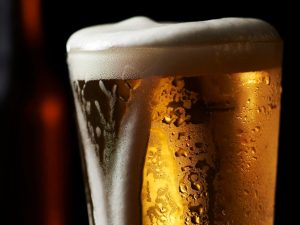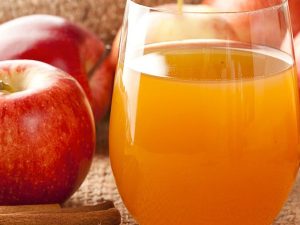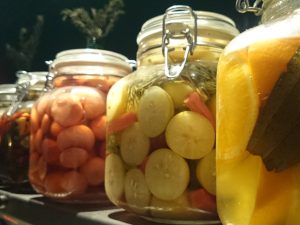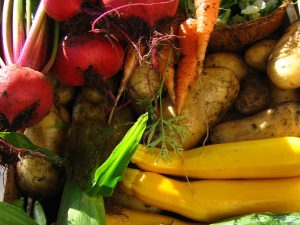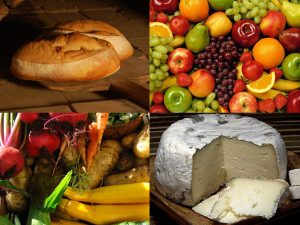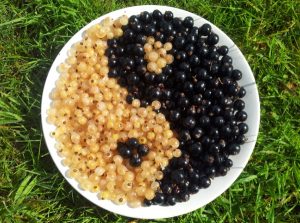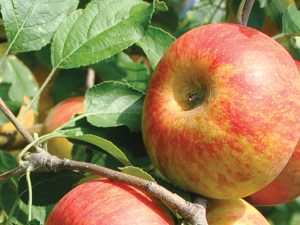Winemaking - introduction
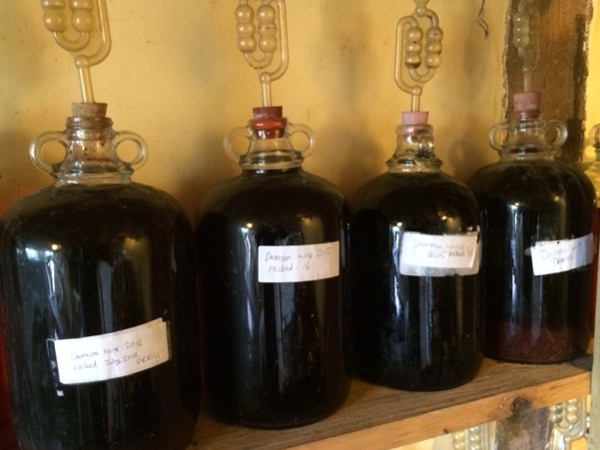
“Wine is bottled poetry” – Robert Louis Stevenson
Contents
What is winemaking?
Wine is an alcoholic beverage made from fruit or plant material via a process of fermentation (conversion of sugar to alcohol). Shop-bought wines are usually made from grapes, but ‘country wines’ can be made from any fruit, flower, herb or vegetable (or honey, in the case of mead).
Yeast converts sugar into alcohol (ethanol), which is usually toxic to microbes – but not to yeast, which can survive in alcohol levels of up to 20%. This is why even high-alcohol wines such as port are no stronger than that.

Making wine from plants other than grapes can be a little more challenging. Grapes’ acidity, sugar and tannin levels make them the ideal fruit for winemaking – so much so that the word wine itself is from the same root as the vine that grapes grow on. Wine from other plant material will usually need sugar, tannin and acid levels adjusted.
Wine can be still or sparkling – i.e. with or without carbonation. This can happen naturally, or CO2 can be injected. A person who makes wine is known as a winemaker or vintner; the science of winemaking is oenology or enology; and the growing of grapevines is called viticulture.
The difference between red, rosé and white wines is to do with the grape skins. You can’t make red wine from white/green grapes, but you can make white wine from red grapes, because the pigment is in the skin, not the juice. If you ferment red grape juice with the skins you get red wine, and if you separate the skins before fermentation, you get white wine. Rosé is produced by allowing a short period of fermentation with the skins.

History
Winemaking started around 7-8000 years ago, in the Caucasus region, between the Caspian and Black seas. The Egyptians were keen on winemaking, but it really took off with the Greeks, and then the Romans, who spread it around their empire, including Britain, which apparently produced especially fine wines.
When the Roman Empire adopted Christianity, wine became a central part of the sacraments. For this reason, winemaking became popular amongst monastic orders, notably the Benedictines. In the 1500s, the Catholic Conquistadors introduced viticulture and winemaking to the New World, after which it spread worldwide.
Country wines were an important part of the medieval medicine cupboard. Elderberry wine was used to treat coughs and colds, and cowslip wine for insomnia. Corks and bottles were introduced in the 17th century, which allowed wines to age for a longer period, in an airtight environment. In the Middle Ages, wine was consumed relatively quickly, before it turned to vinegar.

What are the benefits of winemaking?
Self-provisioning / personal
Alcohol isn’t a necessity, like food, water and shelter, it isn’t for everybody, and some religions proscribe it. But if you’ve decided that you’re going to drink wine, then there are benefits to doing it yourself.
Winemaking is a way of preserving your fruit crop, or fruit and plants that you’ve collected from the wild. Gaining any self-provisioning skills can save you money and bring a lot of satisfaction and pleasure; and home-made wine is great for gifts or social gatherings.
Another reason to make your own wine is the huge amount of choice that you have. Country wines are made from anything that is not a grape. Common fruits include elderberry, damson, crabapple, blackberry, plum, strawberry or pear. Common flower wines include elderflower, dandelion, cowslip, daisy, chamomile or marigold. Some fruits or blossoms are inedible in an unprocessed state – turning them into wine allows you to make use of a wider range of local, natural products.
Making wine is much cheaper than buying it. After an initial layout for equipment, you’ll probably be looking at around 30p per bottle for homemade wine. Granted, shop-bought wines are reliable when it comes to taste, but with a bit of practice, you can make some delicious wines yourself.

Decentralising power away from corporations
Making your own wine means nothing for supermarkets. Providing things for ourselves in communities helps prevent extraction, decentralises power away from corporates (which helps prevent the corruption of democracy) and democratises work.
Building community and preparing for any potential collapse scenarios
In case of any kind of collapse scenario (broken supply chains, environmental destruction, financial crash, war, civil unrest etc.), we’re going to have to look after ourselves in our communities, and so the more people with useful skills the better.
Environmental
Winemaking can make use of a local resource, with short supply chains, and you have control over the way it’s produced – i.e. organically, with very little waste. You’ll be reducing the distance that wines have to travel to get to you – buying Australian or South African wine doesn’t make environmental (or taste) sense in the UK, when we’re surrounded by the world’s greatest wine-producing regions; and if you re-use your bottles, you’ll extend their life and reduce the amount of energy required to make or recycle them.
What can I do?
Just have a go. You may want to start by using grape concentrate or a wine kit – just so that you get the hang of the processes involved, with less chance of producing something undrinkable with your early attempts. If this is heresy to you, just launch into making country wines from the fruit or plant matter available to you. Don’t worry that your attempt at home winemaking is going to make anyone ill. Wines tend to have an alcohol content of over 10%, and no human pathogen can survive that.
Get yourself some basic equipment, which can be purchased online, at specialist brewing shops, second-hand or at flea markets or car boot sales. This includes demijohns, screw-top bottles (or you could use corks and a corking machine – ask in a brewing shop), air-locks with bungs, muslin cloth, funnel, metre-long lengths of plastic hose and (food-grade) plastic buckets. You’ll probably already have stirring spoons, measuring jugs, knives, chopping boards etc. It’s all reusable and will last for life. Get wine yeast and other additives mentioned below from specialist wine/brewing shops. Baker’s yeast might work, but it’s been bred specifically for the taste it delivers to bread, and will be killed at lower levels of alcohol than wine yeast.
Collect your fruit or plant material. You can buy fruit, but you can keep costs down by picking from the wild – blackberries or elderberries are obvious examples. You could also ask people with fruit trees if you could use their fruit – a lot of fruit in the UK goes to waste, and you could smooth things along by offering a bottle of wine in exchange. Make sure the fruit is ripe.
There are lots of recipes that you can follow online or in books (see resources, below), but before launching into recipes, get to know the fundamentals of the winemaking process. Below is a straightforward method of making fruit wine, with explanations. Quantities of ingredients will depend on the fruit (or other plant material, such as flowers etc.), which you’ll find in recipes. Note that in the case of grapes, you may not need to add anything at all apart from the yeast – not even water. Grape juice is the perfect base for making wine.
NB: there is wild yeast in the air all around us, and some experienced winemakers make use of it in the fermentation process. It’s tricky though, and sometimes it can spoil the flavour. Wine yeast is specially bred for the winemaking process, so it’s better for beginners to use that. In which case, make sure all the implements and vessels you use in all stages of the process are scrupulously clean by washing in boiling water, or by using a Campden tablet dissolved in cold water. It’s more of a risk, and you have to clean more thoroughly if you don’t want to use Campden tablets. Use a bottle brush to clean inside bottles and demijohns.

1. prepare the fruit
- Wash your ripe fruit and remove any rotten bits, stalks, leaves etc. Leave the skins on as they will improve the flavour and colour.
- Then cut up / crush the fruit (you can use a potato masher) in a large plastic bucket, and add almost boiling water; this may affect flavour, so instead, you could use cold water with a Campden tablet.
- After the water / fruit has cooled down, add some pectic enzyme, which helps break down the cell walls of the fruit, releases more juice and prevents haziness in the finished wine.
- You now have a fruit ‘must’; cover and leave it to stand for 2 days for the enzyme to extract all the juice. Stir occasionally with a sterilised wooden stirrer.

2. primary fermentation in the bucket
- Add sugar to the must and stir.
- You can either follow a recipe exactly and hope for the best, or if you want to be more scientific about it, you can use a hydrometer to find the sugar level in your must, and how much alcohol can be produced from it. A hydrometer measures specific gravity (which will drop as sugar turns to alcohol). You can buy a hydrometer cheaply from a wine/beer making shop, or online. It will come with instructions. You’re aiming for at least 10% alcohol in your wine, so you can work out how much sugar you need to add to achieve that. You can experiment with different types of sugar, or just stick to the cheapest, white sugar.
- Dissolve yeast in warm water, add to the mix and stir. Cover with a lid, but not an airtight one – you don’t have to keep oxygen out at this stage.
- You could add some more nutrients, as a lot of fruits won’t have enough to keep the yeast going. You can buy winemaking nutrients, and you can add a cup of strong, black tea, which will provide tannin, to add body and help prevent spoiling.
- To stop your wine tasting flat and lifeless, you can add lemons (citric acid) or raisins (tartaric acid); tartaric acid also provides nutrients for the yeast. You can also buy an acid blend from wine/beer making shops. Follow recipes until you get a feel for it.
- None of these adjustments can be prescribed precisely, however. It depends on the fruit that you’re using, and personal taste – and producing wine to match your taste will come with experience.
- Leave this bubbling mixture in a warm place for a week, stirring daily (but make sure your stirrer is sterilised).

3. secondary fermentation in demijohns
- Pour the liquid into sterilised demijohns using a funnel with a muslin cloth to filter out the pulp.
- When a demijohn is full to the neck, close it with a bung with an air-lock in it – make sure there is water in the air lock, to allow carbon dioxide to escape, but to keep oxygen out. You have to keep out oxygen now, so that the yeast produces alcohol, not vinegar.
- Leave your demijohn(s) in a cool, dark place for at least 6 months; you’ll be able to tell when fermentation is finished, as no more bubbles will be released through the air-lock, and the liquid will be clear.
- During the process, dead yeast cells fall to the bottom to form a sediment; this sediment actually releases flavour, but if you leave it too long, it spoils the wine. To prevent this, when the sediment layer is about an inch (2cm) thick, ‘rack’ the wine – i.e. siphon it into a fresh demijohn with a length of flexible hose, top up to the neck with water and close with a bung and air-lock. Rack the wine each time you get an inch (2cm) of sediment.
- There are various other things that you can do, including adding spices or a little extra sugar; again, it’s impossible to say what will work best, as it depends on what fruit you’re using, what flavours you like, if you’re following a recipe etc. The more experience you get, the more you’ll know how to produce wines to your taste. Experimenting is key.

4. bottling & ageing
- Siphon the wine into sterilised bottles. Seal the bottles (with cork or screw-top), label, with date, and store in a cool, dark place to age.
- When you break the airlock to siphon into the bottles, there is a chance that bacteria could enter that will turn your wine into vinegar; some people suggest adding a crushed Campden tablet to the wine at this point to make sure that doesn’t happen, but others say that it’s not necessary. Experiment to see what works for you.
- Fruit wines are usually best after ageing for about three years; flower wines only need one year to mature. You can make and drink wines much more quickly than this, but wine usually mellows with age. A wine that tastes pretty horrible after 6 months might be the best thing you’ve ever tasted after 2 years.
What goes on at the microbial level is so complicated that winemaking is much more of an art than a science. You never know what you’re going to get, which is what makes it so exciting. Practice is the key, and if you’re patient enough to allow the ageing process to work its magic, you can make some very palatable wines.
Good luck, and cheers!
Further resources
- If you produce or intend to produce wine for sale, you must hold an alcoholic products producer approval (APPA).
- National Association of Wine and Beer Makers (amateur) – lots of useful info.
- Wine Society – co-op supplying wine direct from growers, at a reasonable price.
- Wine Making Guides – lots of recipes
Specialist(s)
Thanks to Fran Blockley of Old Chapel Farm for information.

